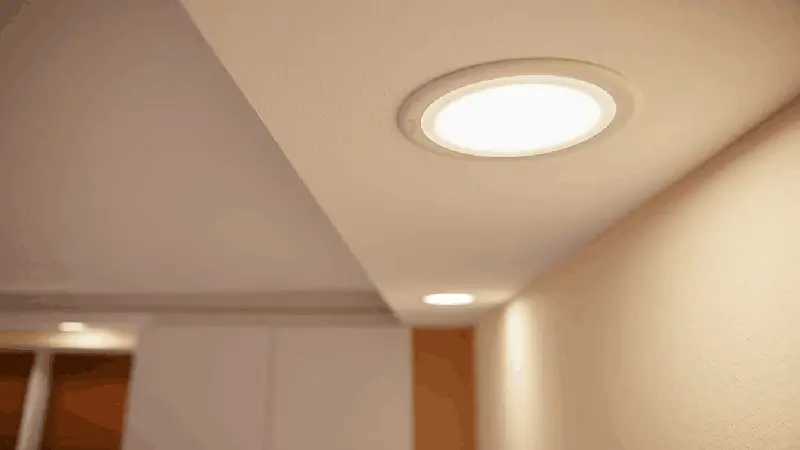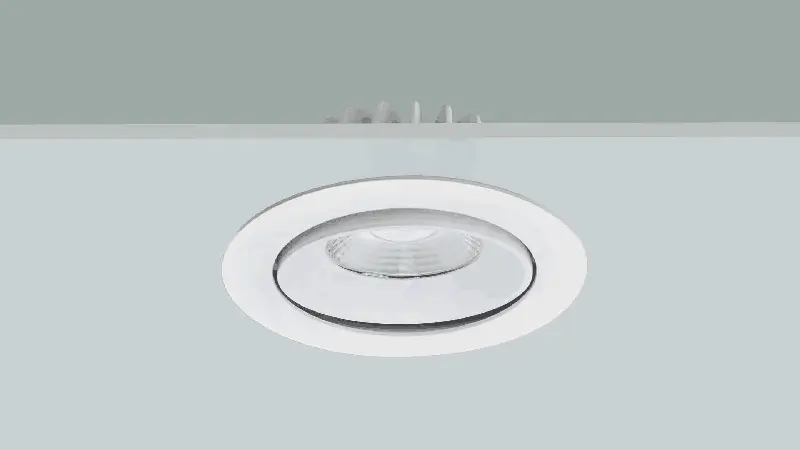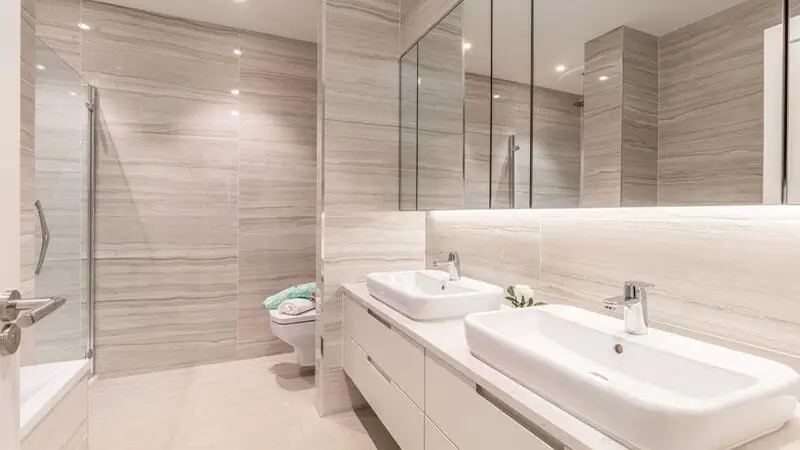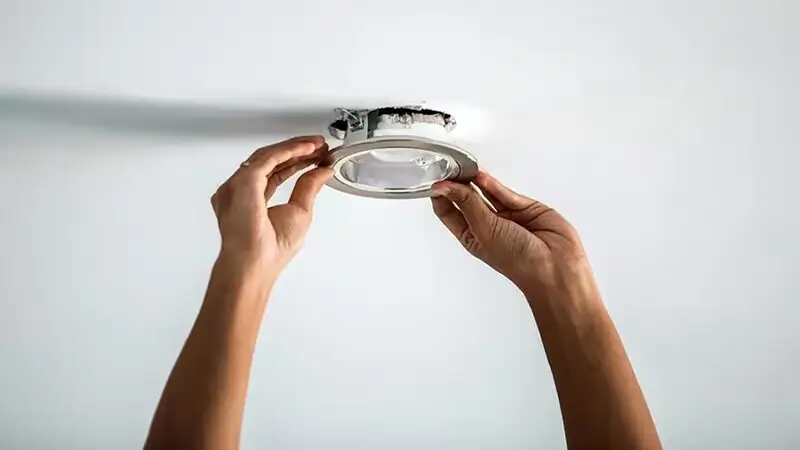
LED downlight is one of the popular lighting fixtures in the lighting market. It provides concentrated and energy-efficient lighting. That is an effective option for illuminating a room and creating a positive vibe. Today, let’s discuss the characteristics, uses, and installation places of LED downlights.
What is An LED Downlight?
LED downlight is a lighting fixture that can be embedded in a fixed position on the ceiling of a home. The most common installation areas include kitchens, living rooms, and bathrooms. Install LED downlights as recessed luminaires in the ceiling, ensuring a flush appearance.

Today’s LED downlights have a variety of work purposes. Examples include accent lighting (focusing on a specific area or object), task lighting (allowing people to perform tasks efficiently), and more.
So, they not only provide efficient lighting but also the extremely pleasing aesthetics of mood lighting. Whether you’re looking to build a modern-looking home or office, LED downlights are a must-have for most ceiling lighting.
Advantages of LED Downlights.
If you choose to install LED downlights in your home/ceiling, there are many benefits. The main advantages are as follows:
- Stylish: The LED downlight provides a modern and stylish look.
- Energy saving: LED downlights are very energy-efficient and save energy consumption.
- Durable: LED downlights have a long lifespan and are more durable.
- Ecological and environmental protection: LED downlights are also very environmentally friendly, saving electricity bills.
- Directional lighting: LED downlights provide directional lighting to highlight specific areas.
- Versatility and flexibility: available in various sizes, designs, and color temperatures
- Save Space: LED downlights can be embedded in the ceiling, saving space and making the room appear larger.
How to Choose the Right LED Downlight? Some Factors.
There are many types and sizes of LED downlights, so choosing the right downlight is critical to achieving the desired lighting effect in your space. Here are the key factors to consider:
LED Downlight Energy Efficiency
The first choice is energy-saving LED downlights. Because they consume less electricity and last longer. While being environmentally friendly, it also reduces electricity costs.
Power and Lumens
First, you need to consider the size of the room and the expected lighting level. Then choose the LED downlight with appropriate wattage and lumen output to ensure sufficient brightness.

Price and Budget
You should set a budget and compare different downlights in the range. Consider the overall value of a downlight, including energy efficiency, longevity, and functionality.
Design Style
Consider the aesthetics of LED downlights. Need to choose a design that blends in with the overall interior and ceiling. Can be beneficial to enhance the overall aesthetics and fashion sense.
Compatibility with Ceilings
If you want downlights to suit your ceiling type. Consider if the ceiling supports LED downlight installation. Choose the installation method, whether embedded or surface-mounted, and other factors.
Beam Angle
The beam angle is important because it determines the spread of the light. Narrow beam angles (approximately 15-30 degrees) are good for accent lighting, while wider angles (approximately 60 degrees) provide more general lighting. You need to choose according to your needs.
Color Temperature
Different color temperatures can express different emotions, it can improve our mood. Warm white (2700-3000K) provides a cozy feel, while cool white (4000-5000K) provides a brighter, more vibrant vibe.
Dimming ability
In general, adjustable lighting is chosen. If you need it, choose downlights that are compatible with dimmer switches. The dimming function can support you to set the desired brightness level on different occasions.
CRI (Color Rendering Index)
CRI represents the ability of a light to accurately render color. Opt for a higher CRI value (above 80) to ensure vibrant and accurate colors. For special venues like art galleries, select CRI>90.
Easy to Install
Check that downlights come with a user-friendly installation process. Some downlights feature quick-connect features or adjustable brackets to simplify installation.
Warranty
Before purchasing, confirm the shelf life of the product with the supplier. So, look for downlights with warranty coverage to ensure support in the event of any defects or performance issues.
Where is the LED Downlight Usually Installed?
Downlights are widely used in residential, commercial, and hospitality settings. Common applications include:

- Living room: LED downlights can be embedded in the ceiling. Installing LED downlights in the living room is mainly to provide general lighting or to highlight a specific area, such as a sofa or artwork.
- Kitchen: Use LED downlights to illuminate kitchen countertops, islands, or dining areas. The main thing is to provide adequate task lighting for the food. At the same time, create a warm atmosphere.
- Bathroom: Install LED downlights in the bathroom. Mainly to provide bright, uniform lighting for grooming activities. You can install them around mirrors, and shower areas.
- Bedroom: Use LED downlights in the bedroom, mainly for mood lighting. There is no need to turn on the main lighting to create a relaxed and comfortable atmosphere.
- Hallways: Lighting hallways with LED downlights can improve visibility without being too glaring. They can be installed along road ceilings to distribute light evenly throughout the space.
- Home Office: Install LED downlights in your home office, primarily to provide adequate task lighting for work areas such as desks and bookshelves. This helps keep you awake and increases your productivity.
- Outdoor Spaces: Use LED downlights to illuminate outdoor areas such as patios, patios, and garden paths. They can provide functional lighting for outdoor events while adding a touch of ambience.
How to Install the LED Downlight?
Installing LED downlights is not a complicated process, but it is best to ask a professional to assist you with the installation. Please follow the steps below for proper installation:

- A. Determine the desired location and mark the location of the downlight.
- B. Make holes in the ceiling according to the measured size and location.
- C. Connect the downlight to the wires, making sure the polarity is correct.
- D. Then fix the downlight on the ceiling, and adjust the direction of the light beam as needed.
- E. Test the lamp and make any necessary adjustments.
Where is the LED Downlight Not Installed?
Although LED downlights are versatile and suitable for a variety of venues, there are a few places where they are not recommended:
Wet areas
Downlights should not be installed in areas that come into direct contacts with water, such as bathrooms and kitchens. Water and water vapor can damage the electrical components of downlights and pose a safety hazard.
Insulated ceilings
Downlights are not recommended for installation in insulated ceilings. Because it can lead to heat buildup and a fire hazard. So there needs to be some clearance around it.
Flammable Materials
Downlights should not be installed near flammable materials such as drapes, drapes, or insulation. Excessive heat generated by downlights may cause a fire.
High-Temperature Area
Downlights are not suitable for areas with high ambient temperatures. For example, near a fireplace, furnace, or heat source. Excessive heat can affect the performance and lifespan of downlights.
Unstable Ceilings
Downlights are not recommended if the ceiling is structurally weak. Vibration or movement can loosen accessories and pose a safety risk.
What Should be Paid Attention to When Installing LED Downlight?
Before installing the LED downlight, in order to use the LED downlight safely and correctly. There are a few important caveats and considerations to keep in mind:
- Safety precautions: Before installing LED downlights, be sure to turn off the power to the installation area. Also, remember to turn off the power before checking the connections. Doing so minimizes the risk of electric shock or injury during installation.
- Ceiling structure: It is necessary to first inspect and evaluate the ceiling structure and determine whether it is suitable for installing downlights. Also check for obstructions above the ceiling, such as wires, pipes, or structural beams.
- Electrical Compatibility: The power supply or electrical system you choose must be compatible with the LED downlight. It is also necessary to ensure that the voltage and power of the power supply can bear the load of the LED downlight.
- Heat dissipation: LED downlights generate heat, so ensure proper heat dissipation. It is critical to prevent overheating and maintain lamp life. So leave a little space to ensure effective heat dissipation.
- The installation depth of the downlight: first confirm the thickness of the ceiling material, and support a few centimeters of downlight. Then choose the appropriate downlight installation depth, design, and specifications.
- Design and layout: plan the placement and layout of downlights to achieve ideal lighting effects and coverage. Consider factors such as the size of the room, its purpose, and any specific areas or functions that require focused lighting.
Summary
This article mainly explains what a downlight is, as well as the properties and uses of a downlight. And how choose the right downlight needs to consider factors such as wattage, beam angle, color temperature, dimming ability, and energy efficiency. By evaluating your specific needs and preferences, you can find downlights that will enhance the ambiance and function of your space.
FAQs
LED downlights use light-emitting diodes (LEDs) as the light source. When electricity passes through the semiconductor material in an LED, it emits light. Outside the downlight, the light can be guided and focused downwards, providing powerful lighting.
LED downlights have many advantages such as energy saving, long life, low heat emissions, instant brightness, and a wide range of design options. They also offer excellent dimming and can be dimmed to create different lighting moods.
Yes, LED downlights are widely used in residential and residential lighting projects. They are ideal for general lighting in living rooms, kitchens, bedrooms, and bathrooms. At the same time, they can also be used for accent lighting to highlight specific areas or architectural features.
You need to choose the structure of the ceiling, the desired brightness, color temperature, beam angle and decoration style, and other factors. Also, make sure downlights are compatible with all your electrical systems, including dimming systems.
OK. But you’ll want to choose LED downlights that are designed for wet locations. Be sure to find downlights with the proper IP (Ingress Protection) rating to ensure they are suitable for these environments.
